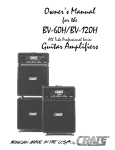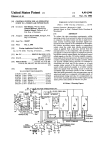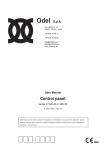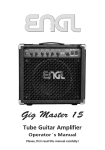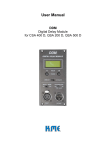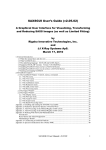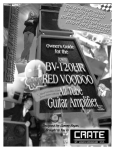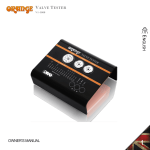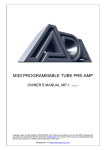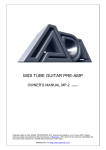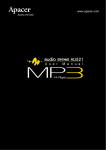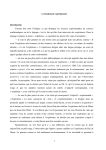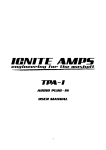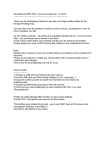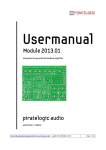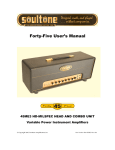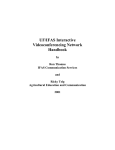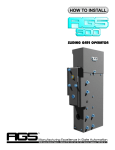Download ADA Ampulator Owner`s manual
Transcript
OWNER’S MANUAL Originally written by ADA SIGNAL PROCESSORS, INC. Scanned and editted by Jur at 20th of november 2002. Original ADA logo and Ampulator logo edited and rendered by Barend Onneweer of Raamw3rk (http://www.raamw3rk.net) The version of this manual is copyrighted and may not be sold or placed on a website without permission of the editor. Release No.3 for http://www.adadepot.com/ ADA Ampulator owner’s manual Contents INTRODUCTION PRECAUTIONS GENERAL FEATURES CONNECTIONS & APPLICATIONS SECTION I, PUSH-PULL TUBE AMP & POWER EMULATOR AMPULATOR CENTERFOLD ILLUSTRATION SECTION II, MIKED CABINET EMULATOR SECTION III OUTPUT AMPULATOR SUGGESTED SETTINGS SPECIFICATIONS WARRANTY RETURNING UNITS FOR SERVICE Page 2 of 13 ADA Ampulator owner’s manual INTRODUCTION Plugging the output of any guitar preamplifier directly into a mixing console, although highly convenient, seldom yields the desired sound and responsiveness demanded by guitarist. It is therefore necessary to use a separate guitar power amplifier and speaker cabinet which is then miked. It is this miked signal which is brought into the console for recording and mixing. The power amplifier and speaker system are just as much a part of a guitarist’s sound as the guitar itself, the preamp, and effects processors in a guitarist’s rack. In addition to the preamp, power amp, and speaker cabinet, most reproduced music has the unavoidable (and therefore expected) coloration resulting from the type and placement of microphones used to capture the sound. The AMPULATOR was conceived to conveniently restore a11 these missing factors to a preamp directly connected to a mixing console, without compromising the all-important “feel” essential to the guitarist. The guitarist can simply dial-in power-amp and speaker cabinet characteristics on the AMPULATOR while listening through the studio’ s reference monitors in the control room. In addition, the AMPULATOR saves hours in microphone selection and placement while eliminating any risk of picking up ambient noise. The ever increasing number of virtual environment studio’s have long been demanding a single comprehensive device that addresses this need, empowering them to expand the list of studio services that they can offer. Many digital and/or software based recording studios can't accommodate guitarists because these studios lack the microphones and isolation booths necessary for recording guitar, which is commonly done at high volume for best tonal results. The AMPULATOR uses a uniquely designed vacuum tube circuit which operates in a push-pul1 transformer-coupled circuit just like high output tube power amplifiers do. To capture the different sonic qualities which distinguish one type or brand of tube amp from another the AMPULATOR gives the user full control of the characteristics responsible for giving any tube power amp its distinctive personality. Uniquely, the AMPULATOR'S circuitry allows the user control over such normally inflexible characteristics as maximum power, amount of crossover distortion at low signal levels, presence of artifacts such as hum and transformer notch distortion, triode or pentode output tube behavior, and output stage symmetry or matching. Included in the AMPULATOR'S miked cabinet emulator section are numerous combinations of loads which behave (and therefore influence the power amp' s behavior) in the same ways as speakercabinets of various types do when connected to high power amplifiers. Any guitar tone finally heard by the listener is also affected greatly by the type and number of speakers driven by the amplifier system. Since speakers must be miked when recording the mike placement and type of mike used also affects the final sound achieved, as was mentioned. The AMPULATOR eliminates the need for any cabinets or miking by allowing user-selectable miked cabinet arrays to be called up at the push of a button. ABOUT THIS MANUAL Success in the use of this product is solely dependent on an understanding of its behavior and intended purpose. Every feature is linked to, and interacts with, every other feature making a simple feature by feature explanation difficult if not impossible. This manual's organization reflects this fact. Like the AMPULATOR, this manual is divided into 3 basic sections: Push-Pull Tube Amp & Power Emulator, Miked Cabinet Emulator, and Output. Additionally, there is an explanation of rear panel connections. To locale information about a feature. simply turn to the applicable section and look for that feature in BOLD type within the text. There are various cross-references throughout of a particular feature's interaction with other features. The explanations loosely follow the order of the AMPULATOR's front panel features from left to right. A diagram of the AMPULATOR's front & rear panels is provided in the center of this manual for reference purposes. Page 3 of 13 ADA Ampulator owner’s manual PRECAUTIONS Read Me First! SETUP WARNING: DO NOT PLUG YOUR AMPULATOR OUTPUTS INTO THE AMPULATOR INPUTS. The AMPULATOR will accept single-ended or balanced signals at instrument level or line level only. A signal from a power Amplifier will overload and may damage the AMPULATOR. 1. WARNING: To prevent fire or shock hazard, do not expose this appliance to rain or moisture. 2. CAUTION: To prevent electric shock, do not remove cover. No user serviceable parts inside. Refer servicing to qualified service personnel. 3. Use ground lift switch on rear panel if necessary to eliminate any line noise or hum that may represent from poorly balanced power sources or ground loops in your system. GENERAL FEATURES AND APPLICATIONS • • • • • • Balanced/unbalanced 1/4" input Unbalanced 1/4" line output. XLR output, mic/line selectable, ground lift. Uses standard 9 pin vacuum tube in unique push-pull transformer coupled circuit. Truly reactive power amp loads cause interaction with tube power amp circuit. Variety of miked speaker cabinet attributes. IN THE STUDIO • • • Allows guitar preamp to be run direct to tape by eliminating need for guitar power amp, speaker cabinet, and mike setups. Restores missing dynamic characteristics often lost when running guitar preamp directly into board. Makes use of emulation techniques to eliminate need of using radicul EQ and effects at the mixing desk. FOR THE LIVE PLAYER • • Allows types of power amplifier personality to be dialed in without using multiple amplifiers. Achieves identical speaker cabinet and tube amp tone even when playing direct into PA board eliminating mike bleed and feedback. Page 4 of 13 ADA Ampulator owner’s manual CONNECTIONS Input The AMPULATOR requires a line level input signal such as the output of a guitar preamp (we recommend ADA MP-2, or MP-1), mixing console Send, or guitar amplifier effects send. The input jack: will accept up to +20dBV (about 8 Vrms) balanced or unbalanced. For unbalanced operation any shielded.1/4” phone plug cable will automatically select unbalanced input signals. If you are running balanced lines in a studio or highly noisy environment, you will need an RTS (ring, tip, sleeve) type 1/41” plug. The + signal is received on the tip, the signal is received on the ring, and the shield may be connected to the sleeve of the connector. Do not plug the speaker output of an ampIifier into the AMPULATOR as damage may occur. For proper operation do not plug an instrument directly into the AMPULATOR. Output The AMPULATOR output is simultaneously available line level unbalanced via a ¼” phone jack and balanced via a separate XLR connector. The signal at the XLR connector is line level (0dB) or mike level (-30 dB) as selected by a rear panel switch. The max signal output before overload occurs is + 19dBm. The XLR connector has a pin 1 ground-lift switch useful for eliminating some types of ground loops. Power Requirements The AMPULATOR voltage and Current requirements are stated on the rear panel. In the USA the requirement is 117VAC +10% / -1.5% 60 Hz, 20 watts maximum. It is not possible to change the voltage rating of an AMPULATOR internally. Operation of the AMPULATOR outside of its line voltage range may result in damage to the unit. The required fuse in USA is 3/16 Amp, Slo-Blow, 250V. Page 5 of 13 ADA Ampulator owner’s manual SECTION I PUSH-PULL TUBE AMP AND POWER EMULATOR Input, Power level Controls and Indicators As with any amplification device the AMPULATOR will distort signals that are too great for it to amplify cleanly. For many guitar tones overdriving the power amp is a necessity. The indicators next to the DRIVE LEVEL controI monitor conditions in the AMPULATOR output stages and used to achieve the desired amount of tube distortion. A CLEAN indicator means that the input signal is not large enough to cause tube compression or tube clipping in the AMPULATOR. Some distortion will be present if the bias is set to an extreme A B or B Class of operation even when the CLEAN LED is on, this is crossover distortion, (see figure 1 to understand crossover distortion) which is actually more audible at very small signal levels. Increasing the signal strength Of DRIVE LEVEL control or reducing the available headroom by reducing the POWER LEVEL will result in the onset of compression (indicated by COMPRESS LED) in the AMPULATOR output stage. This is the start of actual tube distortion which gradually becomes more severe as level is increased until the OVERDRIVE LED indicates full powerclipping. Increasing the level further will not result in any more output, just more tube distortion and, if used, more hum (see HUM INJECTlON) The POWER LEVEL control helps simulate the differences between high and low power amplifiers. At its extreme maximum, the internal tube amplifier exhibits a scaled-down version of 200 watt performance. At this setting there is a lot of available head room and most signals can be passed with great transparency. As the signal level is increased at this power level the compression range is also at its greatest and large transients can be applied without actually triggering the OVERDRIVE condition. (Please note that the OUTPUT CLIP LED on the right hand side of the AMPULATOR is not part of the lube overdrive section and is a warning that the OUTPUT LEVEL control is set too high for the signal conditions and must be backed off). When the POWER LEVEL is at its minimum the transition from clean to overdriven is almost instantaneous, as the amplifier is now truly starved for power. Operation of triodes at extremely low power levels is not recommended.(due to its terrible sound quality) as there is almost no range of compression and triodes won't operate linearly with such small plate supplies. Intermediate settings of the POWER LEVEL control produce a progressively wider range of compression and more remote overdrive limits. Typical POWER LEVEL settings for guitar amplifier emulation lie between 9 o'clock. and 3 o'clock. The AMPULATOR behaves as a mild distortion unit for POWER LEVEL settings less than 9 o’ clock and at these settings can take a clean preamp output and distort it quite effectively. Page 6 of 13 ADA Ampulator owner’s manual Presence Control & Damping Factor Amplifiers benefit from a technique of design called negative feedback. This feedback has nothing to do with squealing instruments and microphones. It is a way of reducing unwanted distortion getting a “flatter” frequency response and improving control of the speaker damping factor. All this is achieved with only a small loss of input sensitivity (typically 12dB). In a CLASS AB amplifier, negative feedback is always applied to smooth out the crossover distortion that occurs at low signal levels. The problem is that this technique no longer works when the amplifier is driven into hard clipping, at which time negative feedback disappear and damping factor, crossover distortion and frequency response all suffer. To faithfully reproduce amp behavior, negative feedback is used in the AMPULATOR circuits as well. The PRESENCE control on all popular tube amplifiers is part of the negative feedback circuitry. When it is advanced clockwise it is actually reducing the negative feedback at high frequencies. This allows the tube amp to run uncorrected at high frequency and appears to he boost high frequency response, until the amp clips at which time the apparent high frequency boost disappears. Circuitry in the AMPULATOR allows exact duplication of this behavior by placing a PRESENCE control in the negative feedback circuitry of the power amp. Flat frequency response is obtained at levels below clipping when the PRESENCE control is set to minimum. Damping factor refers to the power amp’s ability to prevent the speaker’s cones from continuing to move when the electrical signal stops moving. Speakers, being mechanical components, have mass and inertia which, must be overcome by the signal from the amplifier. To the listener this characteristic is typicalIy most noticeable at low frequencies where cone movement is greatest. Tube amplifiers have different damping factors depending on the tube type (Triode or Pentode), the type and amount of negative feedback, and the quality of the output transformer. In general, the damping factor of an amplifier will determine how “loose” the bottom end sounds and to what degree a change in speaker cabinet type, (i.e. open/closed back) will cause a corresponding difference in sound. To allow the AMPULATOR to emulate the tonal differences caused by changing damping factor, the output section can be connected to various loading conditions identical to those encountered by amps connected to various different speaker systems. See "Miked Cabinet Emulator" Section II. See also CHARACTER. Matching AMPULATOR Output Tubes Output tube mismatching in most commercial tube amplifiers causes excessive distortion, premature output transformer saturation, increased hum and a loss of power and efficiency. Although, unlike commercial amps the AMPULATOR can safely be adjusted for mismatched conditions if desired, assuring proper output tube matching will give the most accurate emulation of typical commercial amplifier behavior. TUBE MATCHING should be checked in the AMPULATOR after warm-up and may need readjustment. from time to time, particularly after any large change in TUBE BIAS, or POWER LEVEL control setting or sometimes when changing CHARACTERISTICS between Triode and Pentode tube types. The procedure for checking this is very simple and is done with the aid of the HUM INJECTION control. To adjust the TUBE MATCHING control, first turn HUM INJECTION to maximum and simply listen to me AMPULATOR output signal with no input signal present. If turning the HUM INJECTION control to maximum does not cause an audible increase in hum, then the TUBE MATCHING control needs no adjustment. If hum does increase, it is then necessary to find the position at which the hum is minimized. At this point the output stage is matched and HUM INJECTION control can be returned to the desired position (see HUM INJECTION for other uses of this control.) A couple or notes on TUBE MATCHING: First, although the normal position for matching to occur is near the center of rotation, if the POWER LEVEL control is set very low (around 8 o'clock or less) the power stage may not be able to achieve a matched condition, particularly Page 7 of 13 ADA Ampulator owner’s manual for triodes which do not always track at low powers. Second, while operating HUM INJECTION, TUBE BIAS, and TUBE MATCHING controls you must turn them slowly to avoid excessive noises which circuits may make if suddenly disturbed. Third, be aware that the TUBE MATCHING function is not a hum reduction control. If hum is present at the AMPULATOR's input it ,will not be reduced by this adjustment. If TUBE MATCHING does not seem to be working, turn the DRIVE LEVEL to minimum, select the CHARACTER, switch for PENTODE, and adjust TUBE BIAS until CLASS "A" LED is lit. At this point any mismatch should be clearly detectable as HUM INJECTION is brought to maximum. Once you have set the TUBE MATCHING control in this way, it should only need occasional checking and readjustment. Hum Injection Accurate emulation of commercial amplifiers requires user control of some idiosynchrasies that are normally considered unavoidable consequences of design. There is an often overlooked, but very significant subtlety to the sound of a tube-amp when it is driven into hard clipping by excessive input signal. This subtlety is the increase in power supply hum which modulates the output signal at twice the AC power line frequency. In terms of sound, the results are quite astounding to the listener as the sound take, on a new, more complex color that is absent from any signal that has not passed through a tube power amp. The AMPULATOR allows the amount of hum “injected” from its power supply to readjusted over a range corresponding to that encountered in commercial power amplifiers thereby restoring a missing quality often obtained only by using amps, speakers or power attenuators and microphones in the studio. The second function of the HUM INJECTION control is in the setting of output TUBE MATCHING. When the output tubes are matched accurately, hum from the power supply does not appear at the out put of the amp. Large amounts of hum are usually present in most amplifiers simply because it is expensive and inefficient to remove it. In the case of the AMPULATOR, which allows the output to be mismatched purposefully if desired the perfectly matched condition is checked by injecting a lot of hum from the power supply and adjusting the TUBE MATCHING control until the residual hum at the AMPULATOR's output is minimized. (please see ”Matching AMPULATOR Output Tubes” for more detail). Unless the AMPULATOR is driven well into OVERDRIVE condition position of the HUM INJECTION control will have no effect. The same is true of commercial power amplifiers. To hear the effect of HUM INJECTION clearly it is best to play a single note, preferably a high one with a wide finger vibrato or slowbend. Be sure to overdrive the AMPULATOR very hard (OVERDRIVE indicator lit constantly), also be sure NOT TO CLIP THE OUTPUT. As you increase the HUM INJECTION you wiII clearly hear the 120 Hz undertone appear. Note that it is only present when you play hard enough to overdrive this AMPULATOR circuitry. Overdriving the AMPULATOR does not harm it in any way. It is an essential part of the character of many guitar tones. (See OVERDRIVE). Bias Setting and Class of Operation The bias voltage level of an amplifier is the most critical setting for achieving the correct mixture of power, distortion, and efficiency. In any amplifier the optimum bias voltage will depend on the electronic components used to assemble the amplifier as well as tube age, and construction of the tube(s) used in the design. Slight variations in tubes and other electronic components usually make it best to provide an adjustment for bias so that a technician can optimize the amplifier's performance to be within its designed class. There are three basic amplifierclasses used for guitar amplification: CLASS A, CLASS AB and CLASS B. In commercial amplifiers the class of operation is chosen when the design is conceived. In conjunction with the fixed component values chosen by the designer, the class of operation determines what the correct bias voltage will be. If this bias is altered significantly from its optimum setting in a commercial amplifier, the amplifier will generally fail Page 8 of 13 ADA Ampulator owner’s manual to perform well, or be damaged. This is not true for the AMPULATOR, which has a unique circuit allowing the bias to range anywhere from CLASS A operation through CLASS AB to CLASS B. By changing the position of the TUBE BIAS control the user determines the actual class of operation. Below is a table summarizing the effects of different classes of operation for the same output tubes. As a general role, the vast majority of guitar amplifiers with powerratings greater than 5 watts are of the CLASS AB PENTODE type. This offers the best compromise of power, distortion, efficiency and damping factor. If you are not looking for CLASS DISTORTION OUTPUT POWER EFFICIENCY DAMPING FACTOR A LEAST LEAST POOR 25% HIGH AB COMPROMISE SLIGHTLY LESS THAN CLASS B ABOUT 60% MID B EXCESSIVE HIGHEST ABOUT 75% LOW something distinctive or unusual, most authentic sounds can be emulated in the CLASS AB PENTODE mode of operation. Two types of tubes are commonly used in power amp applications. The names TRIODE and PENTODE refer to the number of electrical elements inside the glass bulb. At any particular POWER LEVEL and CLASS of operation, a TRIODE will tend to have a better damping factor and a larger range of compression before actual signal clipping occurs. The TRIODE is also significantly less efficient and its use as a power amplifier for audio signals was essentially abandoned in the 1950’s with the advent of tubes like the 6V6GT, 6L6GT, 5881, 6550, KT88, EL34, 6BQ5 etc., all of which are PENTODES. PENTODES are everything that TRIODES are not: efficient, undistorted over a wide range and exhibit a very poor damping factor (which is corrected with negative feedback in most designs) making PENTODES the tube of choice. Because TRIODE behavior is so different from PENTODE behavior, the AMPULATOR'S CHARACTER switch allows you to compare how amps of essentially the same power would behave if using one or the other. Use of PENTODE will give accurate representation of most amps, but those TRIODES should not be ignored when looking for tight and compressed sounds having only slight distortion. When using the AMPULATOR TUBE BIAS control to select a class of operation, observe the CLASS LED's as you rotate the bias control with NO SIGNAL PRESENT. Regardless of conditions or output tube CHARACTER selected the LED indicator will display the CLASS of current operation. In the presence of signal these LED's will often flicker or change. This is normal operation and does not indicate a change of operating CLASS merely the normal changes in output stage currents with signal present. As a general role, the vast majority of guitar amplifiers with powerratings greater than 5 watts are of the CLASS AB PENTODE type. This offers the best compromise of power, distortion, efficiency and damping factor. If you are not looking for something distinctive or unusual, most authentic sounds can be emulated in the CLASS AB PENTODE mode of operation. Two types of tubes are commonly used in power amp applications. The names TRIODE and PENTODE refer to the number of electrical elements inside the glass bulb. At any particular POWER LEVEL and CLASS of operation, a TRIODE will tend to have a better damping factor and a larger range of compression before actual signal clipping occurs. The TRIODE is also significantly less efficient and its use as a power amplifier for audio signals was essentially abandoned in the 1950’s with the advent of tubes like the 6V6GT, 6L6GT, 5881, 6550, KT88, EL34, 6BQ5 etc., all of which are PENTODES. PENTODES are everything that TRIODES are not: efficient, undistorted over a wide range and exhibit a very poor damping factor (which is corrected with negative feedback in most designs) making PENTODES the tube of choice. Because TRIODE behavior is so different from PENTODE behavior, the Page 9 of 13 ADA Ampulator owner’s manual AMPULATOR'S CHARACTER switch allows you to compare how amps of essentially the same power would behave if using one or the other. Use of PENTODE will give accurate representation of most amps, but those TRIODES should not be ignored when looking for tight and compressed sounds having only slight distortion. SECTION II MIKED CABINET EMULATOR In the recording environments it is often tedious and time consuming to determine optimum placement for guitar speakers and microphones. Using the AMPULATOR, the effects of cabinet and room size variations as well as mike placement can be duplicated wv1thout leaving the control room. When the CABINET BYPASS switch is engaged, it will lock out the 3 switches labeled SPEAKER ARRAY. In this configuration, the full range output of the AMPULATOR power amp section is sent directly to the OUTPUT LEVEL control without speaker or mike emulation. This sound, which lacks the tone shaping and output loading associated with speaker cabinets, wiII likely sound too bright in the studio environment. CABINET BYPASS mode is ideal for the performing musician who wants to play into a high power rack mount solid state amp connected to a guitar type cabinet, or several guitar cabinets. In this case, CABINET BYPASS mode allows a variety of tube power amp nuances to be passed on to the solid state amp. The solid state amp can be set up so that it is never driven into clipping by the AMPULATOR. Engaging the 1, 2, or 4 SPEAKER ARRAY buttons inserts the cabinet emulation circuits between the amplifier section and the output level control of the AMPULATOR. The 1, 2, and 4 indicate the number of speakers in the emulated cabinet. The next three buttons (SIZE, DRIVER, & CABINET) select the speaker size, either of 10" or 12" in diameter, BRIGHT or DARK tone, and OPEN or CLOSED back cabinet design. An OPEN back cabinet tends to be less damped than a CLOSED back cabinet. Because actual loading conditions are being varied to the power amp when these switches are selected, the open/closed back condition will cause low frequency behavior that will be dependent on the amount of damping the power amp setup dictates, (see PRESENCE and damping factor, see also CHARACTER). Following the push button section of the cabinet emulator are the EQUALIZATION controls for the cabinet selection. The LO RESONANCE allows the addition of a peak at low frequencies similar to the peak in many cardiodid type microphones when they are placed close to the sound source. This is commonly known as proximity effect. The HI BALANCE sets the final rate and cutoff frequency of the high frequencies in the emulated speaker cabinet. Since this is also governed by mike axis it can be viewed as a control of the microphone's angle of placement to the cabinet The +6dB setting would he fully on axis. Cutoff frequency changes with rotation of this control sweeping the range of 1khz to about 6khz. The final roll off is 18dB/octave which is in keeping with most guitar speaker cabinets. If the mixed array configuration is not wanted, partially pressing any unengaged SPEAKER ARRAY button will pop all SPEAKER ARRAY buttons out while still leaving the OPEN/CLOSED CABINET function and the LO RESONANCE and HI BALANCE controls active. Some engineers and performers may prefer to work with this smoother sound. SECTION III OUTPUT Output level Control and System Bypass The OUTPUT LEVEL allows matching the level of the signal leaving the AMPULATOR to the level coming into it. The circuitry in the miked cabinet emulation and in the output driver section of the AMPULATOR should never be allowed to distort as this is not part of the Page 10 of 13 ADA Ampulator owner’s manual characteristic distortion of a tube power amp. The OUTPUT CLIP LED tells the user when the OUTPUT LEVEL control needs to be brought down The SYSTEM out/in button completely bypasses all tone modifying circuits and level controls. When the button is out you will hear the signal which appears at the input jack. This can be used for comparison, and to check the setting of the output level control. Page 11 of 13 ADA Ampulator owner’s manual AMPULATOR SUGGESTED SETTINGS TUBE MATCHING TRANSPARENT MARSHALL CLEAN CLEAN VOX AC30 CLASS A CHAMP CLASS A POWER AMP DISTORTION COMPRESSION DRIVE LEVEL off clean clean Compress Compress compress Overdrive PRESENCE n/a n/a 12:00 off off off any setting TUBE MATCHING set for no hum match match match full ccw match match HUM INJECTION max 0 max 3:00 2:00 0 max TUBE BIAS A A AB A A A B 10:00 max 2:00 11:00 9:00 11:00 10:00 CHARACTER pentode pentode pentode pentode pentode triode any setting SPEAKER ARRAY bypass bypass 4 2 1 1 ,2 or 4 1,2 or 4 POWER LEVEL SPEAKER SIZE - - 12” 12” 10” 10” or 12” 10” or 12” DRIVER - - Bright Bright Bright Bright or dark bright or dark CABINET - - closed open open open or closed open or closed - - - - - - singIeended powersupply triode compression push-pull power amp distortion LO RESONANCE - - 12:00 HI BALANCE - - 9:00 initial setting for tube shows that sound can be unaltered NOTES - Page 12 of 13 - ADA Ampulator owner’s manual SPECIFICATIONS Dimensions Width Depth Height Weight : : : : : 1 rack unit 19” 58” 1 ¾” 5.6.lbs. 6.6 Ibs. (shipping) Maximum Input Maximum Output Input Impedance Vacuum Tube : Power consumption : : : +20 dBV +19 dBm 50k ohms One 12AX7A 10 Watts 117 VAC 60 Hz 220 VAC 50 Hz optional 100 VAC 50/60 Hz optional : ADA Part Number 701069 - Version 2.0 WARRANTY ADA AMPULATOR is warranted against defects in material and workmanship for a period of three hundred and sixty five (365) days from date of purchase. This warranty is to the original owner and is non-transferable. During the warranty period, ADA or its agent will, at its sole option, repair or replace defective parts and make necessary repairs to the product which is defective at no charge. If the failure is the result of misuse, abuse, accident or misapplication, ADA has no obligation to repair or replace the failed product. ADA retains the right to make such determination on the basis of factory inspection. ADA will not be responsible for any device damaged by the AMPULATOR. This warranty remains valid only if repairs are performed by ADA or its agents and provided that the serial number on the unit has not been defaced or removed. This warranty is expressly in lieu of all other warranties either expressed or implied. This warranty gives you specific rights. You may have other rights that vary from state to state. RETURNING UNITS FOR SERVICE If your AMPULATOR requires service, please call our Customer Service Department at (510) 532-1152 for a Return Authorization (RA) number and shipping instructions. Do not ship repairs to ADA without an RA number. Page 13 of 13













